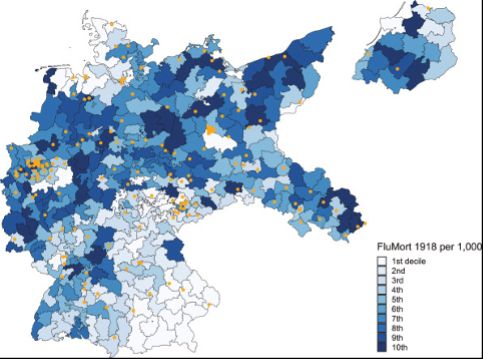
Stefan Bauernschuster
@sbauernschuster.bsky.social
Professor of Public Economics at Uni Passau, Health/ Labor/ Population Economics, ifo Institute, CESifo, IZA
https://sites.google.com/site/sbauernschuster/
https://sites.google.com/site/sbauernschuster/
Mechanisms II: Why was SPD believed to have expertise in public health? In contrast to other parties, SPD and its predecessors explicitly addressed health policy in party programs; SPD particularly concerned with health of workers; SPD strongly involved in health insurance system
January 13, 2025 at 7:39 AM
Mechanisms II: Why was SPD believed to have expertise in public health? In contrast to other parties, SPD and its predecessors explicitly addressed health policy in party programs; SPD particularly concerned with health of workers; SPD strongly involved in health insurance system
Mechanisms I: Not driven by populist and extremist parties; no evidence for punishing/rewarding incumbents; no by-product of dismal economic conditions after World War I. Results in line with issue ownership theory: voters reward competence in salient issues.
January 13, 2025 at 7:39 AM
Mechanisms I: Not driven by populist and extremist parties; no evidence for punishing/rewarding incumbents; no by-product of dismal economic conditions after World War I. Results in line with issue ownership theory: voters reward competence in salient issues.
Validity & robustness checks: Parallel pre-trends ✅; city-level analysis: effect driven by deaths due to respiratory diseases ✅; robust to controlling for large set of covariates, incl., e.g., pre-War poverty, inequality, other mortality phenomena during World War I.✅
January 13, 2025 at 7:39 AM
Validity & robustness checks: Parallel pre-trends ✅; city-level analysis: effect driven by deaths due to respiratory diseases ✅; robust to controlling for large set of covariates, incl., e.g., pre-War poverty, inequality, other mortality phenomena during World War I.✅
Effect size: Moving from a constituency at the 25th percentile of mortality to a constituency at the 75th percentile of the mortality distribution increased the left-wing vote share by 2.1 percentage points or 12.4 percent of a standard deviation. Effect is persistent.

January 13, 2025 at 7:39 AM
Effect size: Moving from a constituency at the 25th percentile of mortality to a constituency at the 75th percentile of the mortality distribution increased the left-wing vote share by 2.1 percentage points or 12.4 percent of a standard deviation. Effect is persistent.
Method and data: We exploit a panel of voting results containing 14 elections from 1893 to 1933 across all 362 constituencies of the German Empire and the Weimar Republic in a difference-in-differences design and combine this panel with a measure of Spanish flu mortality in 1918.

January 13, 2025 at 7:39 AM
Method and data: We exploit a panel of voting results containing 14 elections from 1893 to 1933 across all 362 constituencies of the German Empire and the Weimar Republic in a difference-in-differences design and combine this panel with a measure of Spanish flu mortality in 1918.
Background II: Still, since the pandemic killed around 400,000 people and public life was altered due to widespread sick leaves, the Spanish Flu was arguably salient to voters when elections were held in January 1919, just a month after the 2nd wave had flattened.
January 13, 2025 at 7:39 AM
Background II: Still, since the pandemic killed around 400,000 people and public life was altered due to widespread sick leaves, the Spanish Flu was arguably salient to voters when elections were held in January 1919, just a month after the 2nd wave had flattened.
Background I: The deadly 2nd wave of the Spanish flu hit Germany in late 1918 during the crucial phase of World War I. As authorities did not want to raise concerns of the people, they rejected any interventions and did little to limit the spread of influenza
January 13, 2025 at 7:39 AM
Background I: The deadly 2nd wave of the Spanish flu hit Germany in late 1918 during the crucial phase of World War I. As authorities did not want to raise concerns of the people, they rejected any interventions and did little to limit the spread of influenza
Take-home result: Excess mortality due to the Spanish Flu resulted in a lasting shift of votes towards left-wing parties in the Weimar Republic. Extremists could not benefit from pandemic. Mechanism: As public health became a salient issue, voters rewarded expertise in this issue
January 13, 2025 at 7:39 AM
Take-home result: Excess mortality due to the Spanish Flu resulted in a lasting shift of votes towards left-wing parties in the Weimar Republic. Extremists could not benefit from pandemic. Mechanism: As public health became a salient issue, voters rewarded expertise in this issue
Dazu ein schönes Portrait im Digitalen Forschungsmagazin der Uni Passau @unipassauresearch.bsky.social von @kathaimerl.bsky.social
www.digital.uni-passau.de/beitraege/20...
www.digital.uni-passau.de/beitraege/20...

Mit Algorithmen auf der Suche nach der bestmöglichen Entscheidung
Die "WirtschaftsWoche" hat Prof. Dr. Marc Goerigk von der Universität Passau zum forschungsstärksten BWL-Professor unter 40 Jahren gekürt. Woran er forscht und warum er das Abstrakte schöner findet al...
www.digital.uni-passau.de
December 13, 2024 at 12:24 PM
Dazu ein schönes Portrait im Digitalen Forschungsmagazin der Uni Passau @unipassauresearch.bsky.social von @kathaimerl.bsky.social
www.digital.uni-passau.de/beitraege/20...
www.digital.uni-passau.de/beitraege/20...
Hier ist ein spannendes Papier, das zeigt, dass fest installierte Blitzer wirken, aber nur sehr lokal (Umkreis 500 Meter): www.dropbox.com/s/rupfe4rxqz...
www.dropbox.com
October 6, 2023 at 10:30 AM
Hier ist ein spannendes Papier, das zeigt, dass fest installierte Blitzer wirken, aber nur sehr lokal (Umkreis 500 Meter): www.dropbox.com/s/rupfe4rxqz...

